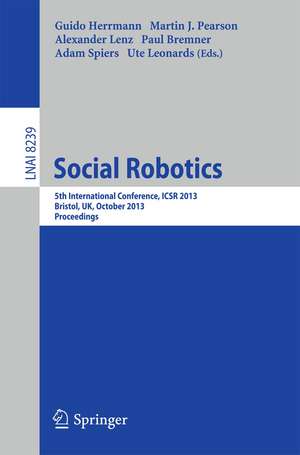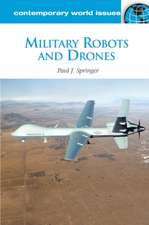Social Robotics
Editat de Guido Herrmann, Martin Pearson, Alexander Lenz, Paul Bremner, Adam Spiers, Ute Leonardsen Limba Engleză Paperback – 11 oct 2013
Preț: 337.11 lei
Preț vechi: 421.38 lei
-20% Nou
Puncte Express: 506
Preț estimativ în valută:
59.65€ • 69.95$ • 52.39£
59.65€ • 69.95$ • 52.39£
Carte tipărită la comandă
Livrare economică 12-26 februarie
Preluare comenzi: 021 569.72.76
Specificații
ISBN-13: 9783319026749
ISBN-10: 3319026747
Pagini: 612
Ilustrații: XVIII, 594 p. 236 illus.
Dimensiuni: 155 x 235 x 33 mm
Greutate: 0.91 kg
Ediția:2013
Editura: Springer
Locul publicării:Cham, Switzerland
ISBN-10: 3319026747
Pagini: 612
Ilustrații: XVIII, 594 p. 236 illus.
Dimensiuni: 155 x 235 x 33 mm
Greutate: 0.91 kg
Ediția:2013
Editura: Springer
Locul publicării:Cham, Switzerland
Public țintă
ResearchCuprins
Building Companionship through Human-Robot Collaboration.- Older People’s Involvement in the Development of a Social Assistive Robot.- What Older People Expect of Robots: A Mixed Methods Approach.- Modelling Human Gameplay at Pool and Countering It with an Anthropomorphic Robot.- Automated Assistance Robot System for Transferring Model-Free Objects From/To Human Hand Using Vision/Force Control.- Robot-Mediated Interviews: Do Robots Possess Advantages over Human Interviewers When Talking to Children with Special Needs?.- Multidomain Voice Activity Detection during Human-Robot Interaction.- A Low-Cost Classroom-Oriented Educational Robotics System.- Social Navigation - Identifying Robot Navigation Patterns in a Path Crossing Scenario.- Affordance-Based Activity Placement in Human-Robot Shared Environments.- Exploring Requirements and Alternative Pet Robots for Robot Assisted Therapy with Older Adults with Dementia.- Smooth Reaching and Human-Like Compliance in Physical Interactions for Redundant Arms.- Recognition and Representation of Robot Skills in Real Time: A Theoretical Analysis.- Robots in Time: How User Experience in Human-Robot Interaction Changes over Time.- Interpreting Robot Pointing Behavior.- Coping with Stress Using Social Robots as Emotion-Oriented Tool: Potential Factors Discovered from Stress Game Experiment.- Study of a Social Robot’s Appearance Using Interviews and a Mobile Eye-Tracking Device.- Playful Interaction with Voice Sensing Modular Robots.- Social Comparison between the Self and a Humanoid Self-Evaluation Maintenance Model in HRI and Psychological Safety.- Psychological Anthropomorphism of Robots Measuring Mind Perception and Humanity in Japanese Context.- The Ultimatum Game as Measurement Tool for Anthropomorphism in Human–Robot Interaction.- Human-Robot Upper Body Gesture Imitation Analysis for Autism Spectrum Disorders.- Low-Cost Whole-Body Touch Interaction for Manual Motion Control of a Mobile Service Robot.- Human-RobotInteraction between Virtual and Real Worlds: Motivation from RoboCup @Home.- Habituation and Sensitisation Learning in ASMO Cognitive Architecture.- Effects of Different Kinds of Robot Feedback.- The Frankenstein Syndrome Questionnaire – Results from a Quantitative Cross-Cultural Survey.- Region of Eye Contact of Humanoid Nao Robot is Similar to that of a Human.- Exploring Robot Etiquette: Refining a HRI Home Companion Scenario Based on Feedback from Two Artists Who Lived with Robots in the UH Robot House.- The Good, The Bad, The Weird: Audience Evaluation of a “Real” Robot in Relation to Science Fiction and Mass Media.- Systems Overview of Ono: A DIY Reproducible Open Source Social Robot.- Sharing Spaces, Sharing Lives – The Impact of Robot Mobility on User Perception of a Home Companion Robot.- Qualitative Design and Implementation of Human-Robot Spatial Interactions.- Unsupervised Learning Spatio-temporal Features for Human Activity Recognition from RGB-D Video Data.- Head Pose Patterns in Multiparty Human-Robot Team-Building Interactions.- I Would Like Some Food: Anchoring Objects to Semantic Web Information in Human-Robot Dialogue Interactions.- Situated Analysis of Interactions between Cognitively Impaired Older Adults and the Therapeutic Robot PARO.- Closing the Loop: Towards Tightly Synchronized Robot Gesture and Speech.- Teleoperation of Domestic Service Robots: Effects of Global 3D Environment Maps in the User Interface on Operators’ Cognitive and Performance Metrics.- Artists as HRI Pioneers: A Creative Approach to Developing Novel Interactions for Living with Robots.- iCharibot: Design and Field Trials of a Fundraising Robot.- “It Don’t Matter If You’re Black or White”?- Effects of Robot Appearance and User Prejudice on Evaluations of a Newly Developed Robot Companion.- A Humanoid Robot Companion for Wheelchair Users.- Tuning Cost Functions for Social Navigation.- Child-Robot Interaction: Perspectives and Challenges.- Training a Robotvia Human Feedback: A Case Study.- Real Time People Tracking in Crowded Environments with Range Measurements.- Who, How, Where: Using Exemplars to Learn Social Concepts.- An Asynchronous RGB-D Sensor Fusion Framework Using Monte-Carlo Methods for Hand Tracking on a Mobile Robot in Crowded Environments.- Using Spatial Semantic and Pragmatic Fields to Interpret Natural Language Pick-and-Place Instructions for a Mobile Service Robot.- Bodily Mood Expression: Recognize Moods from Functional Behaviors of Humanoid Robots.- Cooperative Robot Manipulator Control with Human ‘pinning’ for Robot Assistive Task Execution.- Effects of Politeness and Interaction Context on Perception and Experience of HRI.- Facial Expressions and Gestures to Convey Emotions with a Humanoid Robot.- PEPITA: A Design of Robot Pet Interface for Promoting Interaction.- A Socially Assistive Robot to Support Physical Training of Older People – An End User Acceptance Study.- How Do Companion-Type Service-Robots Fit into Daily Routines of the Elderly to Improve Quality of Life?.- Do Children Behave Differently with a Social Robot If with Peers?.- Is a Furry Pet More Engaging? Comparing the Effect of the Material on the Body Surface of Robot Pets.- Can You Trust Your Robotic Assistant?.- A Robotic Social Reciprocity in Children with Autism Spectrum Disorder.- Learning Complex Trajectories by Imitation Using Orthogonal Basis Functions and Template Matching.- Does Physical Interaction Escalate?.- Being There: Humans and Robots in Public Spaces.- Signaling Robot Trustworthiness: Effects of Behavioral Cues as Warnings.- Activity Switching in Child-Robot Interaction: A Hospital Case Study.- Addressing Multiple Participants: A Museum Robot’s Gaze Shapes Visitor Participation.- Towards a Robotic Sports Instructor for High-Interaction Sports.
Textul de pe ultima copertă
This book constitutes the refereed proceedings of the 5th International Conference on Social Robotics, ICSR 2013, held in Bristol, UK, in October 2013.
The 55 revised full papers and 13 abstracts were carefully reviewed and selected from 108 submissions and are presented together with one invited paper. The papers cover topics such as human-robot interaction, child development and care for the elderly, as well as technical issues underlying social robotics: visual attention and processing, motor control and learning.
The 55 revised full papers and 13 abstracts were carefully reviewed and selected from 108 submissions and are presented together with one invited paper. The papers cover topics such as human-robot interaction, child development and care for the elderly, as well as technical issues underlying social robotics: visual attention and processing, motor control and learning.
Caracteristici
Proceedings of the 5th International Conference on Social Robotics, ICSR 2013













